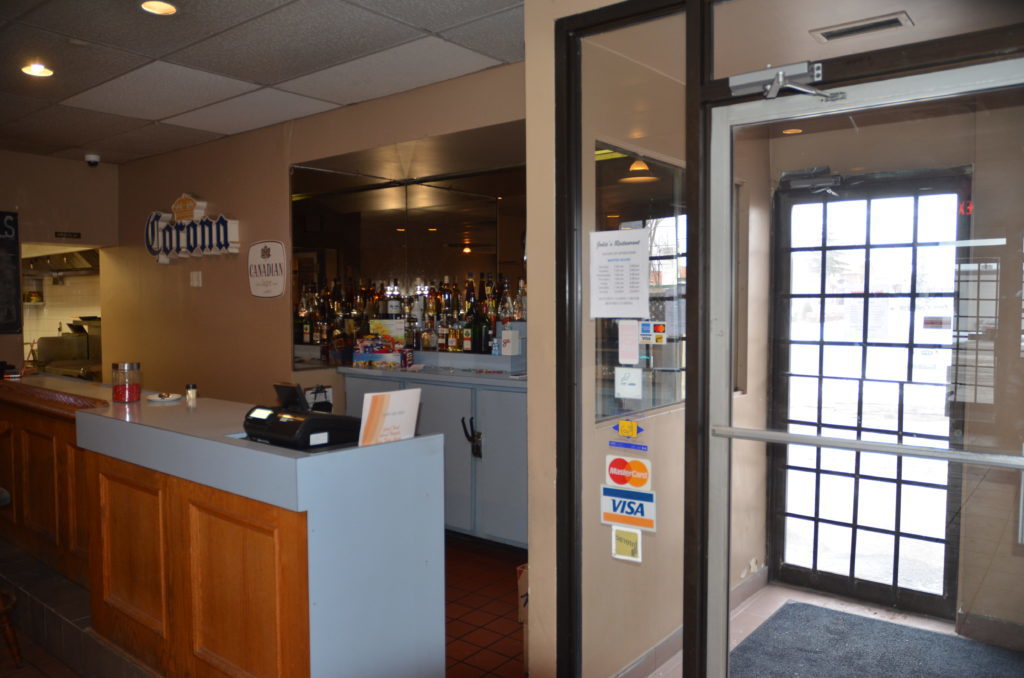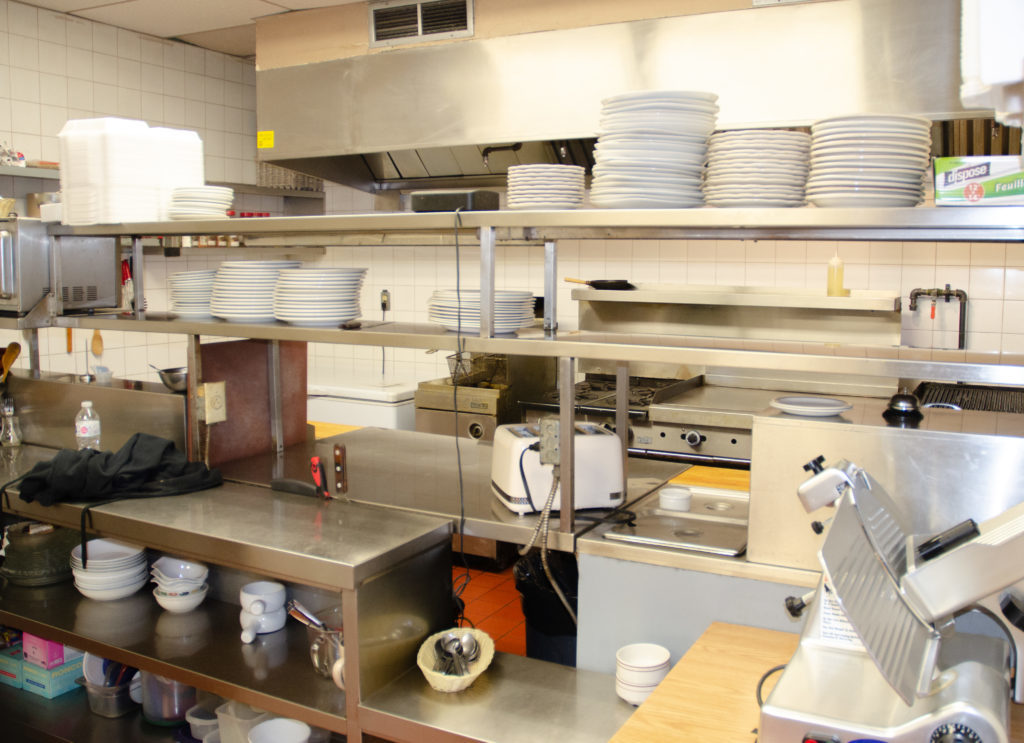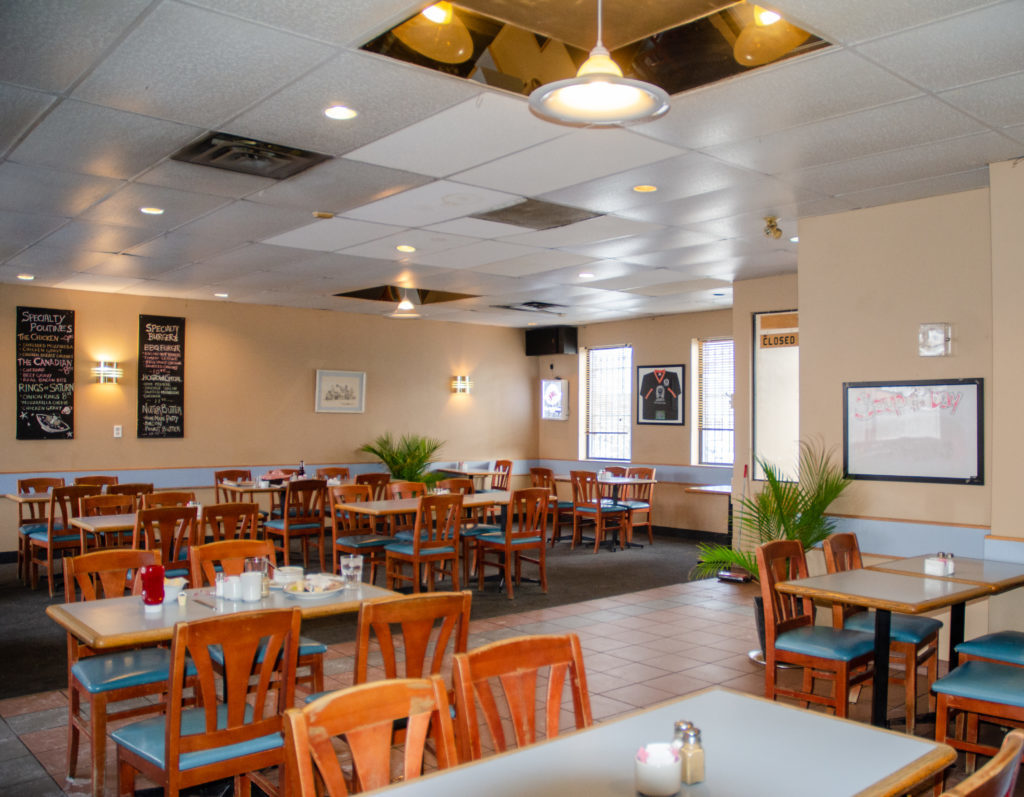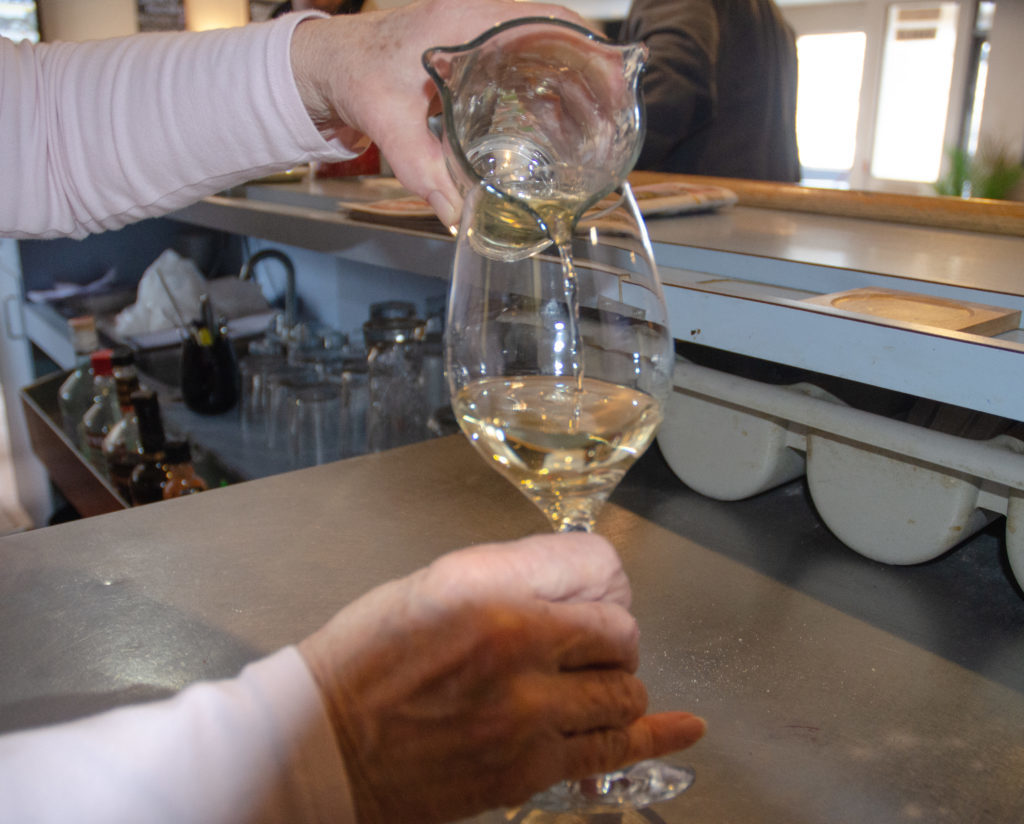By Madison Dolman
“Jodie’s!”
In one swift movement, Jodie Yates picks up the phone with her left hand and tucks it into the crook of her collarbone to hold it in place. With her right, she holds a pan, cooking a pancake over the stovetop, live flames shoot out from under the burner. Almost effortlessly, she flips the pancake, catches it back in the pan and drapes it over the flat top to finish cooking.
“Yes sir, coming right up.” Jodie says through the phone. “See you in 10.”
Jodie scribbles BAC, OE, R on a piece of paper-—shorthand for a breakfast order of eggs over easy and bacon with a side of rye toast—and plates the pancake before starting the next order. Outside the kitchen, the restaurant is buzzing with chatter. The 40-seat restaurant experiences one lunch rush and one dinner rush daily. Two dozen tables are strategically placed on both the carpet and tiled area. With accent countertops of blue and light wood, the restaurant feels cozy and contained. As CTV is broadcast on both TVs, hung up at either end of the restaurant, customers are using the reports of COVID-19 and highway traffic as background noise while they eat. A table of seven chats about their friends’ new band and the hydro plant over drinks. An elderly couple appears at the door and waits patiently as waitress Molly Roberts cleans off the last free table before ushering them over. At this time of day, most are able to sit down and enjoy their lunch hour, relishing every second off the clock—Jodie Yates is lucky if she finds the time in a day to eat even one meal.
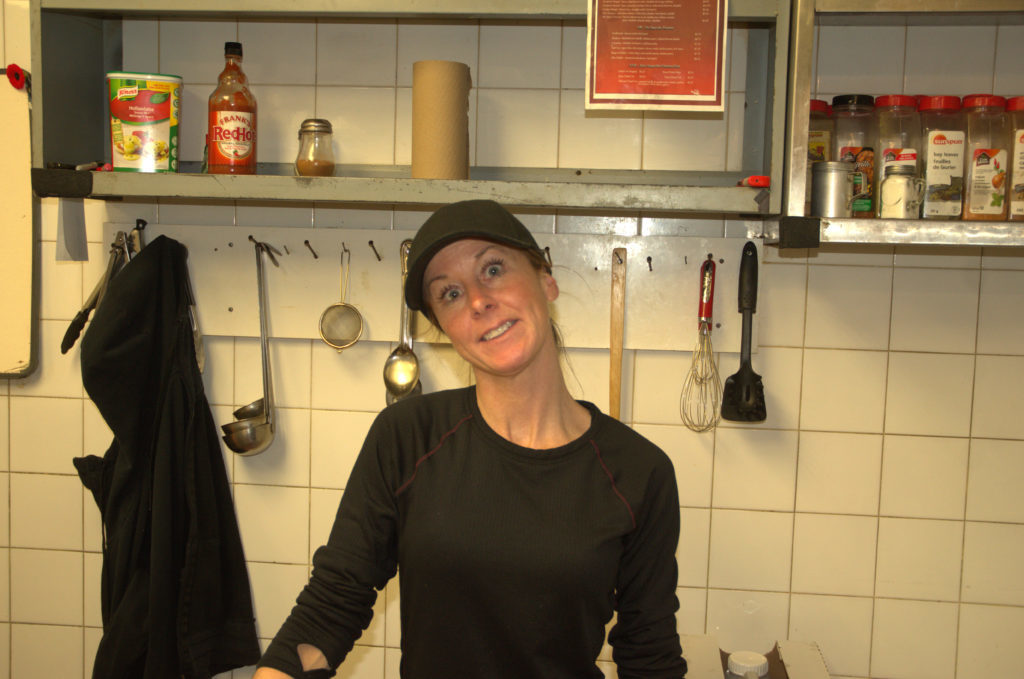
Jodie Yates, waitress-turned owner of Jodie’s Restaurant situated in West Etobicoke (Madison Dolman/T•)
Twenty-three years ago, Jodie started as a waitress in the same building. Her previous boss, Paul Gee, had established it in the 70s under the name Mr. Gees. Jodie served at Mr. Gees for 11 years; using her tip money to help her through college, owning a restaurant had never been the end goal. “[At first], I wanted to be a lawyer. I never thought that I would end up owning a business.” Working full-time while in school, Jodie familiarized herself with the clientele and developed relationships with them, which became a benefit later on.
“Paul passed away in 2007, unexpectedly. Soon after, the landlord approached me and asked if I wanted to buy the business. I felt as though I generated a lot of the clientele since I was a front-line worker here already. I also got a good deal because of my seniority [with the restaurant]. Instead of pursuing law school after college, I invested whatever I had into making the business my own.”

A timeline of Jodie’s Restaurant’s most significant days in existence. (Madison Dolman/T•)
The building structure has started to change with time; the brick appears weathered and the patches of grass grow high on either side of the building. In 1970, a car wash occupied the space where the restaurant now sits. A very obvious cutout takes up the right side of the storefront— it was previously used for cars to drive through. The black paint on the window frames is peeling from the outside and the door hinges squeak with every pull.
“I don’t have control over the outside of the building,” Jodie laughs. “If I did, it sure as hell wouldn’t look like it does, but that’s on the landlord and his laziness. I run a damn business and I would still find time to pull the weeds and fix the potholes in the parking lot, if I were allowed.”
Surprisingly, the building’s blemishes don’t seem to matter much to the regulars of Jodie’s restaurant.
“We’re located in West Etobicoke; pretty close to the lake, pretty close to the detention centre. I don’t really think this affects our business. For the most part, the clientele has been the same for years so it’s kind of your prerogative if you choose to judge Jodie’s by the outside or not,” waitress Chantel Rajotte says.
For Jodie’s, the typical customer turnout is more often than not groups of construction workers, police officers and entrepreneurs, as the restaurant backs onto the lots of many independent businesses and industrial factories. Having worked for Paul, Jodie has set the restaurant’s hours to reflect the demand of customers that visit. “I run a restaurant in an industrial area, which doesn’t demand late hours because everyone shuts down at five o’clock. I’d say I’m killing the game financially, because I don’t have to pay my employees to be here at night when we wouldn’t be making money anyways.”
“Every day at Jodie’s feels relatively similar. You get accustomed to seeing the same people often and learning a lot about them.” says waitress Molly Roberts. Almost on cue, the door creaks open. In walks Ricky, pocketing his cigarettes. He smells of them.
“Hi Ricky, your usual?” Ricky nods, keeping to himself as he walks to his designated spot at a table by the kitchen.
At the coffee bar, Molly begins mixing small amounts of cream, hot water and coffee into a styrofoam cup before passing it off to Ricky.
After Ricky finishes his coffee, he pays with his debit card. “Add 20,” he says, making his round of goodbyes. “We don’t have enough money in this register to keep giving you cash back – go to a damn bank!” Molly shouts as Ricky exits the restaurant.
He does this twice a day, every day, and has been doing it regularly for the last 42 years.
“It’s home. I’m very comfortable here. I have my own table; the waitresses don’t have to ask me what I want. I like it here a lot,” Ricky says.
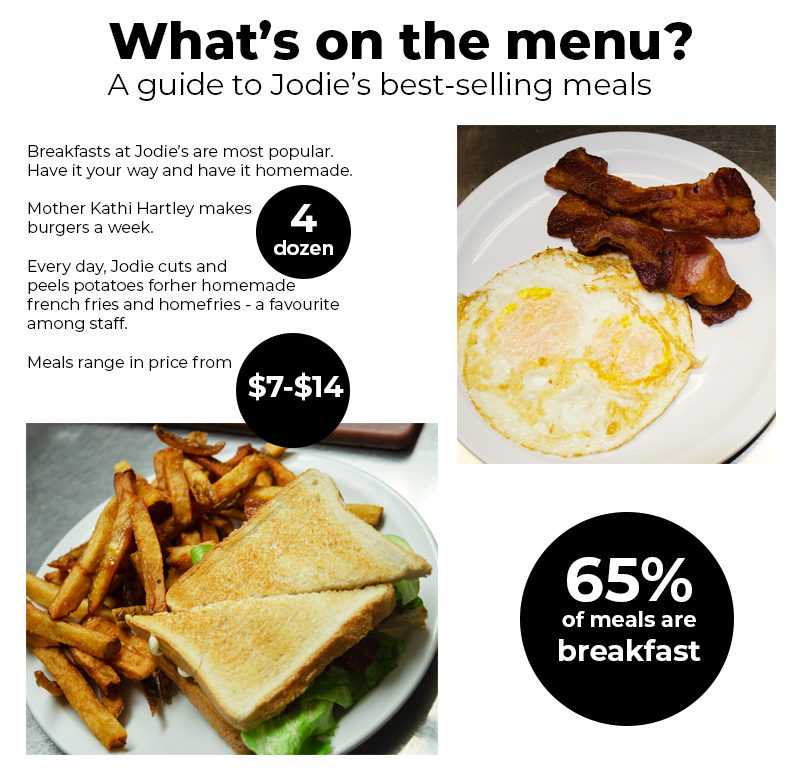
Jodie’s job goes deeper than just cooking the fresh, pub-style food and mouthwatering breakfasts that adorn the pages of the menu. Jodie is also responsible for waiting on customers and doing the paperwork all while maintaining her relationships with her customers. Her small staff of five alternate five-hour morning and afternoon shifts, no more than two working at a time. The busier it gets, the more Jodie helps out—when she’s not cooking she keeps busy by waiting on tables and filling condiments.
“Over the years I’ve gotten to know my clientele very well. I could tell you what their wives’ names are, if they have kids, where they work and how long they’ve had that job. I make the effort that other local businesses may not make.”
By now, the lunch rush is nearly over. Jodie dings the bell and Molly rushes through the double doors for the clubhouse and fries. “Freddie did say no mayo, right?” Molly gives Jodie a thumbs-up with her free hand. Jodie turns and begins kneading ground beef together with spices in a bowl, in preparation for tomorrow’s lunch rush. Her hands callused, her shoulders slumped. The kitchen radio is playing ‘Brown Eyed Girl’ by Van Morrison at a low volume. Outside, the conversations have slowed. The once-packed restaurant begins to empty around 2 o’clock every day—from two to five, only a handful of customers come in, usually for a post-work Caesar or a batch of onion rings. The cash register dings once in a while and a beer bottle gets opened. Soon, Jodie’s will close for the day only to re-open again at 6:30 the next morning for Jodie to do it all over again.

